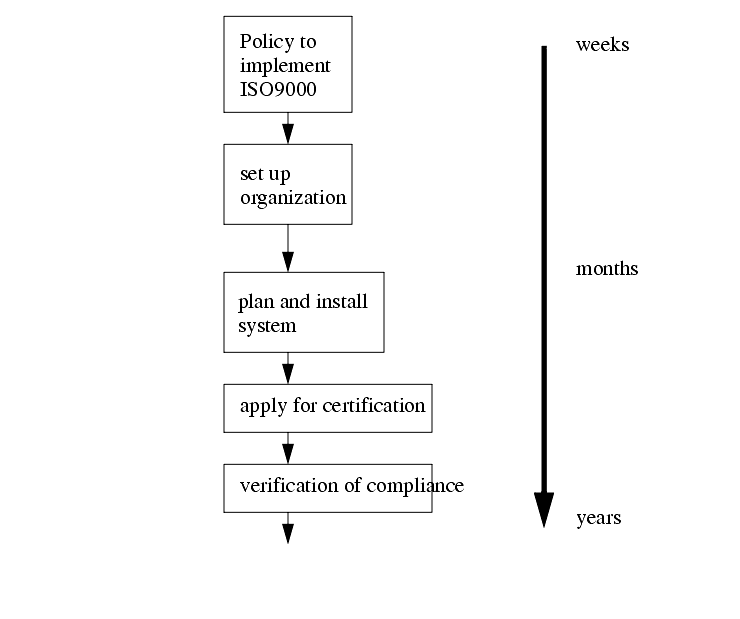16. ISO9000
������������
Originally developed by the ISO Technical Committee TC 176.
A standard aimed at certifying products for quality (e.g., when taking a drivers licence test, they don't care how you learned to drive, only if it conforms to the legal requirements).
This is the first Globally accepted quality designation, and it is replacing many existing quality certification programs, such as those of,
- Telecommunication companies
- US Department of Defense
There are designated certification agencies throughout the world.
The philosophy,
- should be open about all processes, no hiding, no "back-rooms" where `skeletons' are hidden.
- common agreement about quality objectives between suppliers, producer, customers.
- a product, and quality responsibility should be traceable from start to end.
- documentation is required to indicate how production goes from the front end to the customer.
- the documents are to be signed and copies given to everybody responsible. It becomes a "quality bible" for a product.
The standards,
- ISO9000 - directs the selection of the other ISO900x standards and general management policies.
- ISO9001 - The most stringent quality standard requiring conformance from design to service.
- ISO9002 - Looser than ISO9001, requiring excellence in production and installation.
- ISO9003 - Best when only capable of inspection and testing. Even easier than ISO9002.
Overview
Approach to certification.
Information is available from,
- (USA) the National Institute of Science and Technology (NIST), the Department of Commerce, Phone:(301) 975-4031, Fax:(301) 963-2871
What is required for an effective quality system?
- Organizational Structure and Responsibilities
- Processes and Procedures
- Documentation and Implementation of Quality Policy
Standard compliance can be determined by,
- Second party - a customer may audit the suppliers quality system, and verify compliance to one of the standards, with periodic reviews.
- Third party - The accreditation body certifies the program, and conducts periodic monitoring of procedures.
Basic steps for implementation
1. Make a decision to seek certification
- is it required for commercial needs?
- is the organization committed to certification?
2. Determining the state of the existing facility
- assess and identify gaps in processes and documentation
- determine existing compliance
- begin promoting and training for compliance
- select a registration body
- conduct internal and external audits
- auditors will visit and review the application, and the state of the document, etc.
ISO 9001 is the most stringent standard, and the ISO 9002, and ISO 9003 standards are subsets of this, as shown in the table below,
The principles that must be applied to the above areas are,
- each element must be addressed
- the process must be defined
- develop and maintain evidence of implementation
The most typical initial impacts on a company are,
- a culture change where procedures must now be followed
- addition of a system for controlling documents
Significant long term impacts on a company are,
- use of documents to direct work
- ongoing review of quality methods


